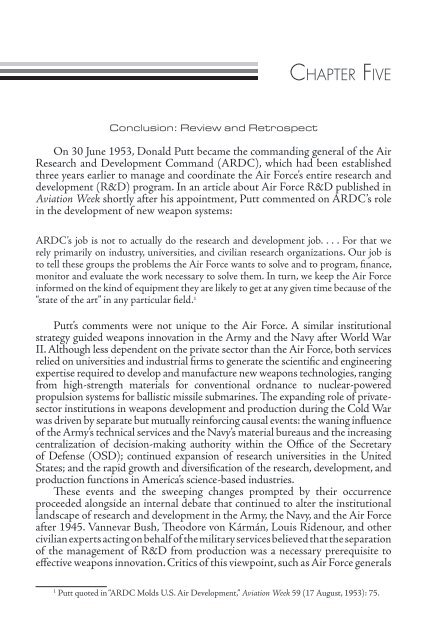To download as a PDF click here - US Army Center Of Military History
To download as a PDF click here - US Army Center Of Military History
To download as a PDF click here - US Army Center Of Military History
Create successful ePaper yourself
Turn your PDF publications into a flip-book with our unique Google optimized e-Paper software.
Conclusion: Review and Retrospect<br />
ch a p T e R fIve<br />
On 30 June 1953, Donald Putt became the commanding general of the Air<br />
Research and Development Command (ARDC), which had been established<br />
three years earlier to manage and coordinate the Air Force’s entire research and<br />
development (R&D) program. In an article about Air Force R&D published in<br />
Aviation Week shortly after his appointment, Putt commented on ARDC’s role<br />
in the development of new weapon systems:<br />
ARDC’s job is not to actually do the research and development job. . . . For that we<br />
rely primarily on industry, universities, and civilian research organizations. Our job is<br />
to tell these groups the problems the Air Force wants to solve and to program, finance,<br />
monitor and evaluate the work necessary to solve them. In turn, we keep the Air Force<br />
informed on the kind of equipment they are likely to get at any given time because of the<br />
“state of the art” in any particular field. 1<br />
Putt’s comments were not unique to the Air Force. A similar institutional<br />
strategy guided weapons innovation in the <strong>Army</strong> and the Navy after World War<br />
II. Although less dependent on the private sector than the Air Force, both services<br />
relied on universities and industrial firms to generate the scientific and engineering<br />
expertise required to develop and manufacture new weapons technologies, ranging<br />
from high-strength materials for conventional ordnance to nuclear-powered<br />
propulsion systems for ballistic missile submarines. The expanding role of privatesector<br />
institutions in weapons development and production during the Cold War<br />
w<strong>as</strong> driven by separate but mutually reinforcing causal events: the waning influence<br />
of the <strong>Army</strong>’s technical services and the Navy’s material bureaus and the incre<strong>as</strong>ing<br />
centralization of decision-making authority within the <strong>Of</strong>fice of the Secretary<br />
of Defense (OSD); continued expansion of research universities in the United<br />
States; and the rapid growth and diversification of the research, development, and<br />
production functions in America’s science-b<strong>as</strong>ed industries.<br />
These events and the sweeping changes prompted by their occurrence<br />
proceeded alongside an internal debate that continued to alter the institutional<br />
landscape of research and development in the <strong>Army</strong>, the Navy, and the Air Force<br />
after 1945. Vannevar Bush, Theodore von Kármán, Louis Ridenour, and other<br />
civilian experts acting on behalf of the military services believed that the separation<br />
of the management of R&D from production w<strong>as</strong> a necessary prerequisite to<br />
effective weapons innovation. Critics of this viewpoint, such <strong>as</strong> Air Force generals<br />
1 Putt quoted in “ARDC Molds U.S. Air Development,” Aviation Week 59 (17 August, 1953): 75.

















